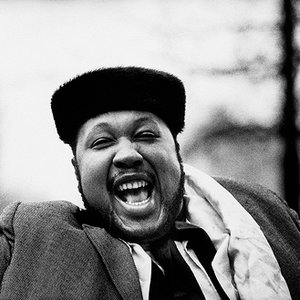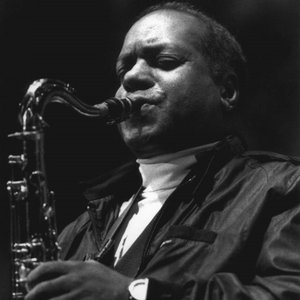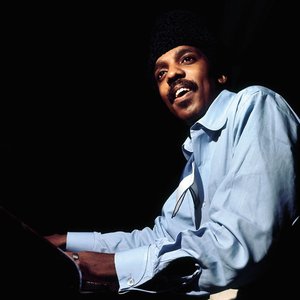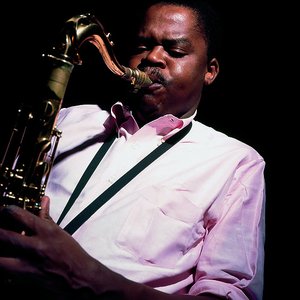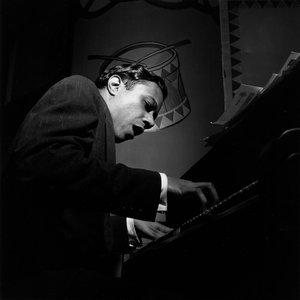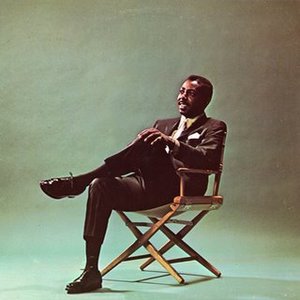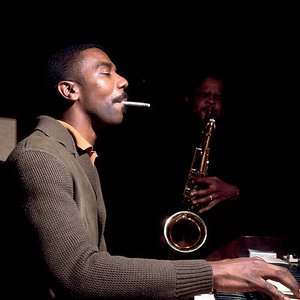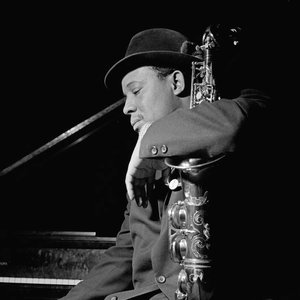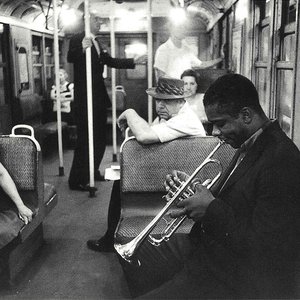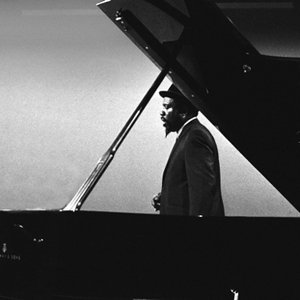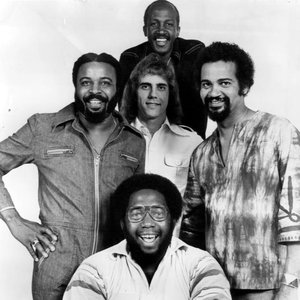Biography
In 1969. Atlantic Records released Swiss Movement, a recording of McCann with regular collaborator and saxophonist Eddie Harris and guest trumpeter Benny Bailey at that year's Montreux Jazz Festival. The album contained the song "Compared To What," and both the album and the single were huge Billboard pop chart successes. "Compared To What" featured political criticism of the Vietnam War:
The President, he's got his war,
Folks don't know just what it's for.
Nobody gives us rhyme or reason,
Have one doubt, they call it treason.
(The song was not actually written by McCann; fellow Atlantic composer/artist Eugene McDaniels wrote it years earlier.)
Wikipedia: Swiss Movement
Leslie Coleman McCann (September 23, 1935 – December 29, 2023) was an American jazz pianist and vocalist. He is known for his innovations in soul jazz and his 1969 recording of the protest song "Compared to What". His music has been widely sampled in hip hop.
Early Life
Leslie Coleman McCann was born in Lexington, Kentucky, on September 23, 1935. He grew up in a musical family with four brothers and one sister, most of whom sang in church choirs. His father was a fan of jazz music and his mother was known to hum opera tunes around the house.
As a youth, McCann played the tuba and drums and performed in his school's marching band. As a pianist, he was largely self-taught. He explained that he received piano lessons for only a few weeks as a six-year-old before his teacher died.
McCann attended Los Angeles City College, which was highly influential to his musical career. At the age of 17, he joined the U.S. Navy in San Diego.
Career
During his service in the Navy, McCann won a singing contest, which led to an appearance on The Ed Sullivan Show. After leaving the Navy, McCann moved to California and played in his own trio. He declined an offer to work in Cannonball Adderley's band so that he could dedicate himself to his own music. The trio's first job was at the Purple Onion club in 1959 accompanying Gene McDaniels.
The main part of McCann's career began in the early 1960s, when he recorded as a pianist with his trio for Pacific Jazz. In 1969, Atlantic released Swiss Movement, an album recorded with saxophonist Eddie Harris and trumpeter Benny Bailey earlier at that year's Montreux Jazz Festival. The album contained the song "Compared to What"; both reached the Billboard pop charts. The song, which criticized the Vietnam War, was written by Eugene McDaniels years earlier and recorded and released as a ballad by McCann in 1966 on his album, Les McCann Plays the Hits. Roberta Flack's version appeared as the opening track on her debut album First Take (1969).
After the success of Swiss Movement, McCann, primarily a piano player, emphasized his vocals. He became an innovator in soul jazz, merging jazz with funk, soul and world rhythms. His music was influential for its use of electric piano, clavinet and synthesizer.
In 1971, McCann and Harris were part of a group of soul, R&B and rock performers–including Wilson Pickett, the Staple Singers, Santana and Ike & Tina Turner–who flew to Accra, Ghana, to perform a 14-hour concert for more than 100,000 Ghanaians. The March 6 concert was recorded for the documentary film Soul to Soul. In 2004, the movie was released on DVD with an accompanying soundtrack album.
McCann had a stroke in the mid-1990s, but he returned to music in 2002, when Pump it Up was released, and continued to release music until 2018. He also exhibited his work as a painter and photographer.
Death
McCann died from pneumonia in a Los Angeles hospital on December 29, 2023, at age 88.
Wikipedia: Les McCann
Eddie Harris (October 20, 1934 – November 5, 1996) was an American jazz musician, best known for playing tenor saxophone and for introducing the electrically amplified saxophone. He was also fluent on the electric piano and organ. His best-known compositions are "Freedom Jazz Dance", popularized by Miles Davis in 1966, and "Listen Here".
Biography
Harris was born and grew up in Chicago. His father was from Cuba and his mother from Mississippi. He studied music under Walter Dyett at DuSable High School, as had many other successful Chicago musicians (including Nat King Cole, Clifford Jordan, Johnny Griffin, Gene Ammons, Julian Priester, and others). He later studied music at Roosevelt University; by that time he was proficient on piano, vibraphone, and tenor saxophone. While in college he performed professionally with Gene Ammons.
After college, Harris was drafted into the United States Army and while serving in Europe, he was accepted into the 7th Army Band which also included Don Ellis, Leo Wright, and Cedar Walton.
Leaving military service, Harris worked in New York City before returning to Chicago where he signed a contract with Vee Jay Records. His first album for Vee Jay, Exodus to Jazz, included his own jazz arrangement of Ernest Gold's theme from the movie Exodus. A shortened version of the track, which featured his playing in the upper register of the tenor saxophone, was heavily played on radio and became the first jazz record ever to be certified gold.
The single, "Exodus", climbed into the US Billboard Hot 100 and reached No. 16 in the U.S. R&B chart. He moved to Columbia Records in 1964 and then to Atlantic Records the following year where he re-established himself. In 1965, Atlantic released The In Sound, a bop album which won back many of his detractors.
During the next few years, he began to perform on electric piano and the electric Varitone saxophone and to perform a mixture of jazz and funk that sold well in both the jazz and rhythm and blues markets. In 1967, his album The Electrifying Eddie Harris reached second place on the R&B chart. The album's second track, "Listen Here", was issued as a single climbing to No. 11 R&B and No. 45 on the Hot 100. Harris released several different versions of his composition over the years, including both studio and live concert recordings. The first appeared on an early Atlantic album, Mean Greens, featuring him on electric piano. He was to re-work the track two years later, stretching it out to over seven minutes in length, for his hit version on which he played saxophone. The entire track appeared on both sides of the Atlantic hit single and edited into two parts. For the 11th Annual Grammy Awards in 1968, Harris was nominated for the Best Instrumental Jazz Performance for Small Group or Soloist with Small Group for the Album – The Electrifying Eddie Harris.
In 1969, he performed with pianist and vocalist Les McCann at the Montreux Jazz Festival. Although the musicians had been unable to rehearse, their session was so successful that a recording of it was released by Atlantic as Swiss Movement. This became one of the best-selling jazz albums ever and was nominated during the 13th Annual Grammy Awards (1970) for the Best Jazz Performance – Small Group or Soloist with Small Group.
Harris also came up with the idea of the reed trumpet, playing one for the first time at the 1970 Newport Jazz Festival. He moved from Chicago to Los Angeles in the 1970s. From 1970 to 1975, he experimented with new instruments of his own invention (the reed trumpet was a trumpet with a saxophone mouthpiece, the saxobone was a saxophone with a trombone mouthpiece, and the guitorgan was a combination of guitar and organ), with singing the blues, with jazz-rock (he recorded an album with Steve Winwood, Jeff Beck, Albert Lee, Ric Grech, Zoot Money, Ian Paice and other rockers). He also started singing comic R&B/blues songs, such as "That is Why You're Overweight" and "Eddie Who?".
In 1975, however, he alienated some of his audience with his album The Reason Why I'm Talking S–t, which consisted mainly of comedy. After recording for Atlantic for over 12 years, Harris left the record company after completing his final album for the label in 1977. He then signed with RCA Records and recorded two albums.
Harris died of congestive heart failure in Los Angeles on November 5, 1996, at the age of 62.
Artist descriptions on Last.fm are editable by everyone. Feel free to contribute!
All user-contributed text on this page is available under the Creative Commons Attribution-ShareAlike License; additional terms may apply.
